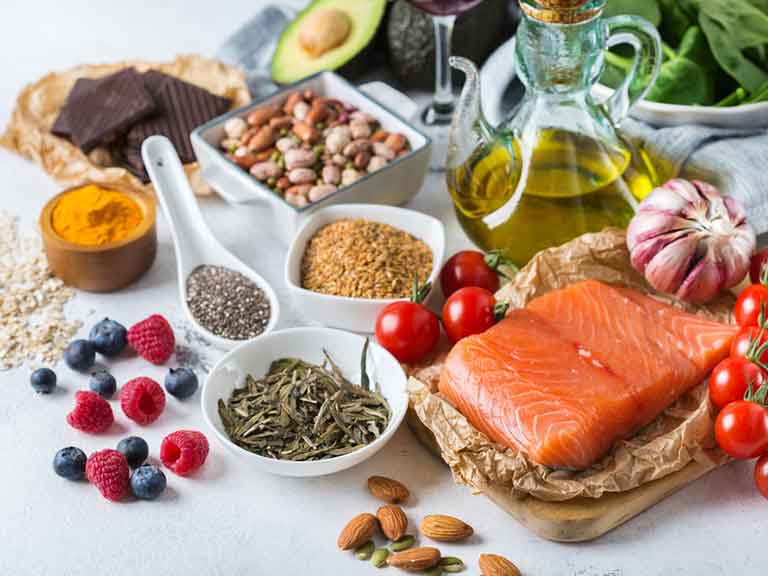By Madeline R. Vann, MPHMedically Reviewed by Kelly Kennedy, RD
Last Updated: 11/15/2019
The Dietary Approaches to Stop Hypertension, or DASH, diet has been consistently ranked by US News & World Report as a top diet for heart health and weight loss, and it’s no surprise why. (1) Unlike fad diets that call for extreme calorie or food-group restrictions without scientific evidence that supports their efficacy, the DASH diet involves making manageable dietary changes that are flexible and rooted in proven nutritional advice.
This has made the eating plan popular among doctors, dietitians, and other health professionals in the United States, where heart disease remains the No. 1 killer among men and women, according to the Centers for Disease Control and Prevention (CDC). (2) High blood pressure (hypertension) is a big contributing factor to heart disease and affects 1 in 3 American adults, per the CDC. (3) It’s not just an American problem, though: Heart disease is also the leading cause of death around the world, according to the American Heart Association. (4)
Whom Is the DASH Diet Good for Exactly, and What Types Are Available?
The DASH diet was developed specifically to help people lower high blood pressure and is promoted by the National Heart, Lung, and Blood Institute (NHLBI), part of the National Institutes of Health. (5) According to the American Heart Association, blood pressure readings higher than 130 millimeters of mercury (mm Hg) for systolic blood pressure and higher than 80 mm Hg for diastolic are considered high. (6)
The food options available on the DASH diet closely mirror the eating plan recommended in the U.S. Department of Agriculture’s MyPlate, with a focus on whole foods, such as fruit and veggies; fat-free or low-fat dairy; whole grains; and lean meats, fish, and poultry. (7) Meanwhile, the plan requires cutting back on, or preferably eliminating, processed foods, like sugary drinks and packaged snacks, and limiting red meat, which in excess has been linked to poorer heart health and heart failure, according to a past study. (8)
The DASH diet specifically meets the low-sodium (salt) requirements that can give people an edge over hypertension. This means it’s a great diet for people who have high blood pressure or have a personal or family history of heart disease, as well as those individuals who may be at risk for type 2 diabetes or are currently managing the condition.
DASH Diet Types
Depending on your health needs, you can choose from two forms of the DASH diet:
The Standard DASH Diet This plan limits sodium consumption to 2,300 milligrams (mg) per day.
The Lower-Sodium DASH Diet This version calls for limiting sodium consumption to 1,500 mg per day.
According to the NHLBI, the daily Dash Eating Plan also involves, on average: (9)
- 6 to 8 servings of grains, preferably whole grains
- 6 or fewer servings of meat, poultry, and fish
- 4 to 5 servings of veggies
- 4 to 5 servings of fruit
- 2 to 3 servings of low-fat or fat-free dairy products (fat-free if watching weight, like with diabetes)
- 2 to 3 servings of fat or oils (preferably healthy fats)
Here are some of the other daily nutritional goals of the DASH diet plan: (9)
- Total fat is 27 percent of calories
- Saturated fat is 6 percent of calories or less
- Protein is 18 percent of calories
- Carbohydrates are 55 percent of calories
- Cholesterol is limited to 150 mg
- Fiber is 30 grams (g) or more
Depending on weight loss or weight maintenance needs, you can choose a DASH diet plan that provides 1,200, 1,400, 1,600, 1,800, 2,000, 2,600, or 3,100 calories per day.
You can track your nutrient and calorie intake for free with Everyday Health's Calorie Counter.
How Does the DASH Diet Work to Help Lower Blood Pressure?
The DASH diet works by limiting not only salt but also saturated fat — both of which can be detrimental to heart health, says Kimberley Rose-Francis, RDN, CDE, a nutritionist based in Sebring, Florida. Sodium-rich salt can drive up blood pressure, which puts unnecessary strain on the heart muscle, Rose-Francis says. Saturated fat, on the other hand, can increase cholesterol levels. “Cholesterol has the potential of blocking or decreasing the flow of blood to the heart,” Rose-Francis says, adding that restricted blood flow could lead to a heart attack.
The DASH diet also works by increasing foods that provide fiber, lean protein, and other nutrients thought to help lower blood pressure.
Also important to note is people who want to lower their blood pressure should combine the diet with other healthy lifestyle approaches to managing hypertension, such as getting more exercise, losing weight, and cutting back on alcohol consumption. Quitting smoking is also crucial for lowering blood pressure and maintaining good heart health.
A 7-Day Sample DASH Diet Menu That You Can Follow
According to the Mayo Clinic, the DASH diet calls for eating lots of fresh veggies and fruits, but it requires consuming only a moderate amount of whole grains, as well as lean sources of protein and healthy fats, such as fish and nuts, respectively. (10) This distinguishes the DASH Diet from other popular plans, such as the Atkins diet and the ketogenic diet, or the high-fat, low-carb diet.
Here’s a typical week of meals on the DASH diet: (11)
Day 1
- 3 ounces (oz) of turkey meatloaf
- 1 small baked potato topped with 1 tablespoon (tbsp) each of fat-free sour cream and low-fat cheese, and a chopped scallion
- 1 small whole-wheat roll
- Cooked spinach
- 1 peach
Day 2
- Egg white omelet with bell pepper and onion
- 1 slice of whole-grain toast
- Tuna salad lettuce wrap
- ½ banana
- 4 oz halibut with ½ cup brown rice and 1 cup asparagus
- An apple
Day 3
- 1 cup slow-cooked oatmeal with 1 tbsp raisins and 1 teaspoon (tsp) honey
- ½ cup blueberries
- ½ cup strawberries
- Whole-wheat pita bread stuffed with lettuce, fresh peppers, shredded carrots, hummus, and low-sodium black beans
- 4 oz grilled chicken with ½ cup zucchini
- 1 peach
Day 4
1 slice of whole-grain bread with 1 tsp jam
- 1 plum
- ½ banana
- Bow tie pasta salad with ¼ cup peppers, ¾ cup whole-wheat pasta, 1 tbsp onion, ¼ cup chopped cucumber, and 1 tbsp olive oil
- 1 cup honeydew melon
- 4 oz tilapia with 1 cup cauliflower and 1 cup green beans
- 1 apple
Day 5
- 1 cup fruit salad (melon, banana, apple, or berries) with 1 cup fat-free yogurt and 1/3 cup walnuts
- 1 bran muffin
- Curried chicken wrap with 3 oz chicken breast, ½ cup chopped apple, 1 ½ tbsp light mayonnaise, and ½ tsp curry powder in a whole-wheat tortilla
- ½ cup baby carrots
- 1 cup fat-free milk
- 1 cup whole-wheat spaghetti with 1 cup no-salt-added marinara sauce
- 2 cups green salad with 1 tbsp low-fat Caesar dressing
- 1 small whole-wheat roll and 1 tsp olive oil
- 1 nectarine
- Trail mix made of ¼ cup raisins, 22 unsalted mini pretzels, and 2 tbsp sunflower seeds
Day 6
- 1 whole-wheat bagel with 2 tbsp peanut butter (no salt added)
- 1 orange
- 2 cups fat-free milk
- Spinach salad with 4 cups of spinach, 1 pear (sliced), ½ cup mandarin oranges, 1/3 cup slivered almonds, and 2 tbsp red wine vinaigrette
- 12 reduced-sodium wheat crackers
- 3 oz baked cod with ½ cup brown rice pilaf and ½ cup steamed green beans
- 1 small sourdough roll and 2 tsp olive oil
- 1 cup of berries with mint garnish
- 1 cup fat-free yogurt
- 4 vanilla wafers
Day 7
- 1 cup oatmeal with 1 tsp cinnamon
- 1 slice whole-wheat toast and 1 tsp trans-free margarine
- 1 banana
- 2 cups fat-free milk
- Tuna salad with ½ cup tuna, 2 tsp light mayonnaise, 15 grapes, and ¼ cup diced celery served on 2.5 cups romaine lettuce with 8 Melba toast crackers
- Kebab with 3 oz beef and 1 cup peppers, onions, mushrooms, and cherry tomatoes
- 1 cup wild rice
- 1/3 cup pecans
- 1 cup pineapple
- Spritzer with 4 oz cran-raspberry juice and 4–8 oz sparkling water
- 1 cup light yogurt
- 1 peach











